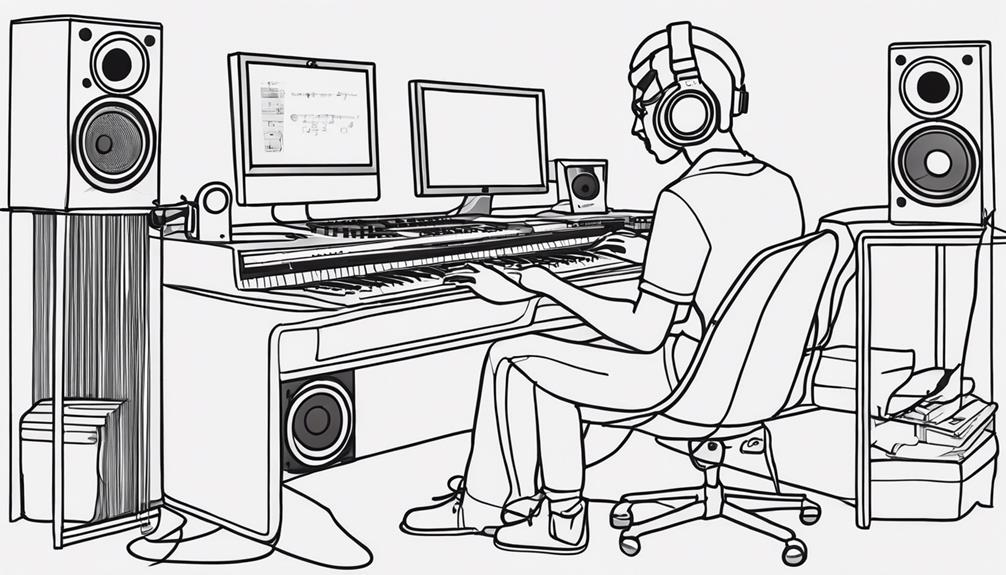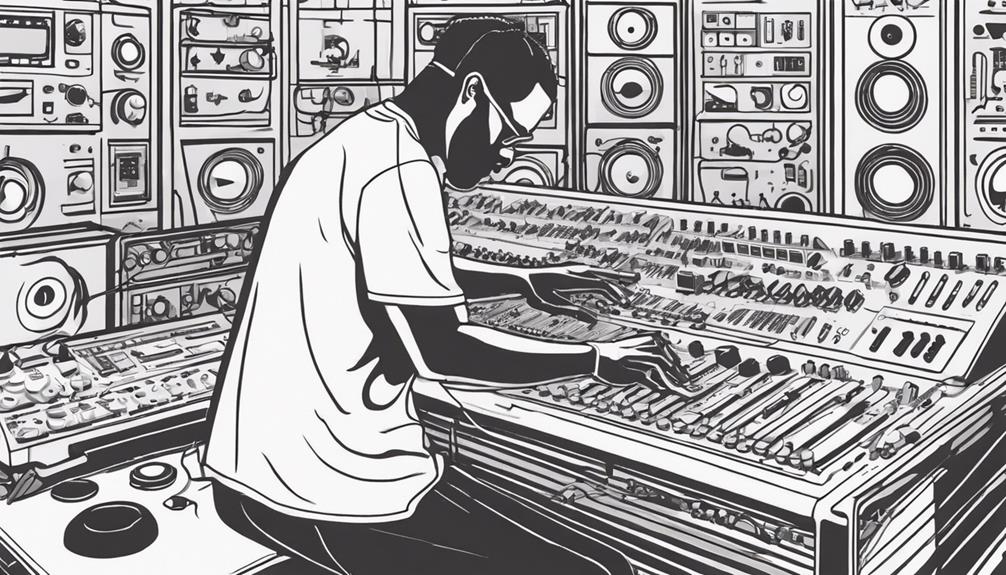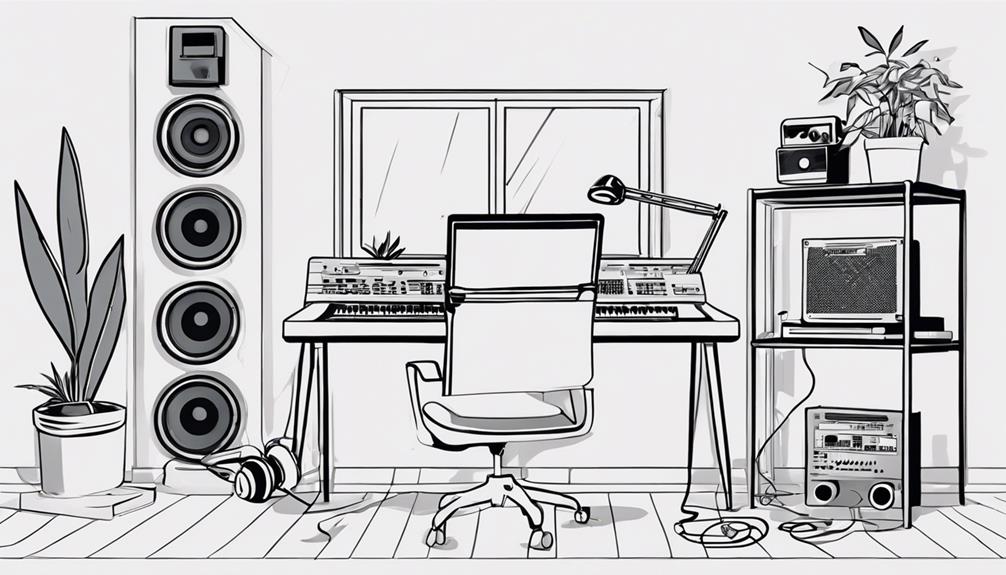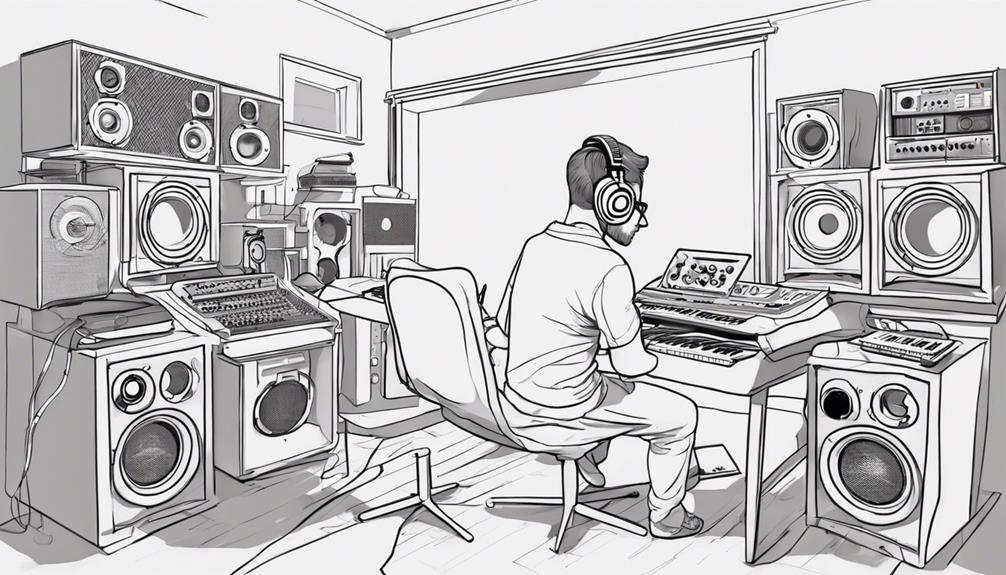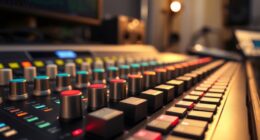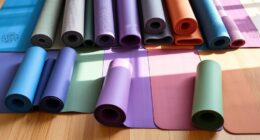To make your own home music production studio, start with essential gear like a powerful computer and digital audio workstation. Get an audio interface and quality microphones for clear recordings. Soundproof by using materials to reduce noise leakage and create a tidy layout with proper cable management. Focus on acoustics by using sound panels and setting up symmetrical studio monitors. Check out reputable brands for quality recording equipment. Enhance your studio vibe with good lighting, ergonomic furniture, and personal touches. Building your DIY studio can be fun and rewarding, leading to great music creation experiences. Don’t forget that one of the key components of your studio is the computer, so you might consider the option to build a PC for music production. This allows you to customize its specifications, ensuring it has enough processing power, RAM, and storage to handle demanding audio projects. With the right setup, you’ll be ready to dive into recording, editing, and mixing with efficiency and creativity.
Key Takeaways
- Soundproofing and acoustics are crucial for reducing noise and enhancing sound quality.
- Invest in essential equipment like microphones, audio interfaces, and studio monitors.
- Optimize studio layout for balanced sound distribution and ergonomic comfort.
- Personalize space with artwork, decor, and lighting to create a conducive creative environment.
- Prioritize durability and quality when purchasing recording gear for long-term performance.
Essential Equipment for Home Studio
To set up a functional home studio, you need essential equipment like a high-performance computer with audio processing capabilities. This computer will serve as the heart of your studio, allowing you to record, mix, and produce music with ease.
Pairing your computer with a Digital Audio Workstation (DAW) is important for creating professional-grade recordings in your home studio. The DAW provides the platform for recording, editing, and mixing your music tracks.
In addition to the computer and DAW, an Audio Interface is essential for connecting microphones and instruments to your setup. Popular choices like the Scarlett 2i2 or Universal Audio Apollo Twin ensure high-quality audio input into your recordings.
To capture pristine vocals, quality microphones such as the Rode NT1A or Audio Technica AT 2035 are a must-have in your studio arsenal.
Setting Up Soundproofing and Acoustics

Implementing soundproofing and acoustics in your home music production studio is essential for achieving excellent recording quality. Soundproofing helps reduce sound leakage by around half, greatly improving your recording conditions.
To enhance soundproofing, consider creating a window plug using dense sound absorption materials. Sealing cracks with sealant and utilizing vocal booths can further minimize interruptions during your recording sessions.
For superior recording quality, acoustic treatment is vital. Acoustic panels are highly recommended to treat reflections and enhance sound quality in your studio. These panels can help control the acoustics of your space, ensuring that you capture clean and clear audio recordings.
Furniture and Studio Setup

Consider selecting ergonomic furniture for your home music production studio to guarantee comfort and prevent fatigue during extended recording sessions. When setting up your studio, keep in mind the following key elements:
- Symmetrical Layout: Position your studio monitors at ear level and create a symmetrical layout to guarantee balanced sound distribution throughout the room.
- Sound Absorbers: Enhance acoustics by adding sound absorbers like foam panels to reduce echo and improve the overall sound quality of your recordings.
- Adjustable Lighting and Cable Management: Opt for adjustable lighting options to set the right mood for creativity in your workspace. Additionally, ensure proper cable management to avoid clutter and potential interference with your recording equipment.
Tips for Buying Recording Gear

When purchasing recording gear for your home music production studio, prioritize essential equipment like microphones, audio interfaces, and studio monitors. It's important to invest in quality recording equipment from reputable brands like Rode, Focusrite, and KRK to guarantee peak performance in your studio.
Consider factors such as USB connectivity and multiple input channels to meet your recording needs effectively.
Before making a purchase, compare prices, read reviews, and seek recommendations from experienced producers to make informed decisions. It's vital to choose durable and reliable gear that will enhance the quality of your recordings and withstand the demands of regular use in your home recording studio.
Remember that the recording gear you select plays a significant role in the overall sound quality of your productions. By choosing the right microphones, audio interfaces, and studio monitors, you can create a professional setup that allows you to achieve your musical goals effectively.
Improving Home Studio Vibe

To enhance the creative atmosphere in your home music production studio, consider the impact of lighting choices on the overall vibe. Proper lighting can set the mood and inspire your musical creativity.
Additionally, organizing your studio layout thoughtfully can boost productivity and spark new ideas during your music production sessions. Personalizing your space with artwork and furnishings that resonate with you can greatly improve comfort and provide ongoing inspiration for your work. Attention to detail in the aesthetics of your studio is essential as it can positively influence the overall ambiance and make the space more inviting. Equally important is taking the time to organize music production files systematically, ensuring easy access to samples, projects, and presets when creativity strikes. Having a well-structured file system not only saves time but also reduces stress, allowing you to stay focused on the creative process. Paired with a well-designed studio layout, this level of organization creates a harmonious flow that keeps your sessions both efficient and inspiring.
When aiming to create a cozy and inviting environment in your home studio, incorporating rugs and decor elements can play an important role. These additions not only enhance the visual appeal of your space but also contribute to a welcoming atmosphere that nurtures creativity. Embrace these elements to transform your home studio into a sanctuary for your musical pursuits.
Frequently Asked Questions
How to Make a DIY Music Studio?
You can create a DIY music studio by choosing a quiet space, setting up gear for ideal sound, testing acoustics, and investing in essential equipment like a computer, DAW software, audio interface, microphone, and studio monitors.
How Much Does It Cost to Build a Home Music Studio?
Building a home music studio can range from $500 to $50,000+. Costs vary based on equipment quality, setup complexity, and additional gear like soundproofing. Start small and upgrade over time to balance budget and quality.
How Do I Set up a Filming Studio at Home?
To set up a filming studio at home, choose a dedicated room with good lighting and ample space. Invest in a high-quality camera, tripod, and microphone. Consider soundproofing to minimize external noise. Add aesthetically pleasing backgrounds for visual appeal.
How Do You Start Your Own Studio?
Start your studio with strategic space selection, ideal gear placement, and acoustics assessment. Equip with essentials like a computer, DAW, interface, and quality mics. Follow recommendations for microphones, monitors, and headphones for precise production.
Conclusion
To sum up, creating a cozy and creative home music production studio is a challenging but rewarding endeavor. By investing in essential equipment, setting up soundproofing, and carefully choosing furniture, you can transform any space into a professional recording studio.
Remember to focus on fostering a fun and functional environment to enhance your music-making experience. With a little effort and creativity, you can craft a charming and engaging music production space right at home.



